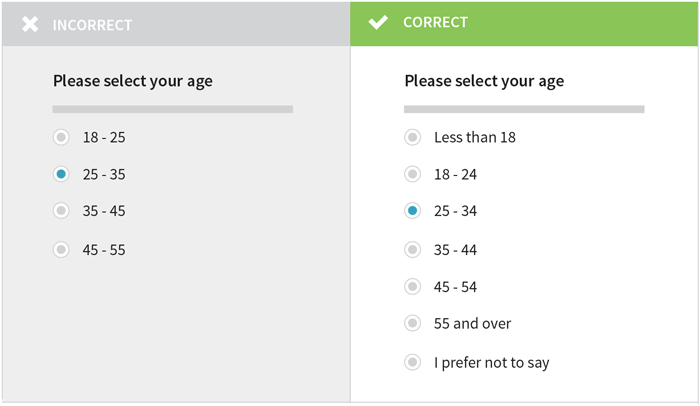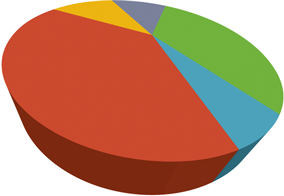How to Use This Book
如何使用本书
Structure of the Book
本书结构
The book’s chapters follow pretty closely the actual set of steps that need to be accomplished before data can be visualized, from the design of the survey to the collection of the data to ultimately its visualization. Really pretty simple. So if you’re fairly new to the game, it is probably going to make sense for you to start at the beginning and read the whole way through the book. Likewise, if you’re familiar with some of the content, but not everything, there’s no harm in just skipping to the chapters that are relevant to your case: you aren’t going to be scrambling to catch up if you skip around!
本书的章节排布基本上依照了数据可视化中需要处理的实际步骤顺序,从设计调查问卷到数据收集到最终的可视化。真的非常简单。所以如果你是一个新手,放轻松,这本书会让你很快上手并且能让你读完它。如果你熟悉本书一部分但不是全部的内容,跳过那几章也没有关系,你不会因此觉得后面的那几章晦涩难懂。
If you don’t have much (or any) experience with survey design and data collection and visualization, it would probably be best to read this book all the way through before you start collecting your data. Some of the visualizations you want to make when everything is said and done might require some well-planned decisions up front. If you’re reading this book part-by-part as you go, there’s a better chance that you might not consider something until it’s too late!
如果你没有太多调查设计、数据收集和可视化的经验,你可能需要在收集数据之前先通读本书。在所有准备工作完成之后,一些你想要的可视化可能需要你提前做一些有计划的决定。如果你是一边做一边看这本书的相关章节,你可能会因为考虑不周而付出一些代价。
Common Terms and Definitions
常见的术语和定义
Throughout the book, there may be times when we introduce specialized terms and phrases that are rather specific to the topic being discussed. Whenever this is the case, we will provide a link to the term in our glossary. You’re welcome to reference this at any time, but we do our best to point you in that direction when a new term is used.
在本书中,有的时候我们会引入一些针对特定主题的专业术语和短语。在这种情况下,我们会提供一个术语表的链接,如果你觉得有必要,欢迎你点击它以获得更多的信息,我们会尽我们所能在一个新的术语出现时提供帮助。
Advanced Chapters
高级篇
This book does contain some chapters that go a bit above and beyond just the basics that we think you should know. We do denote these chapters with a warning at the beginning of the chapter so that you know to expect a more in-depth look at the topic. Reading these chapters (although we recommend it!) is not necessary for an adequate understanding of the broader topic being discussed; however, there are times when we feel that it’s useful to provide you with easy access to the information and that you could benefit from a more thorough understanding of the topic.
这本书确实包含了一些更艰深的内容,但我们认为这对您来说是必要的,我们会在这些章节的开头给予提示。这些章节对于充分理解我们讨论的主题并不是必需的,尽管我们仍然推荐您读一读。我们认为这些章节对于您获得信息以及理解主题都是大有裨益的。
Examples: The Good, the Bad, and the Ugly
示例:好的,坏的,丑陋
One of our favorite parts about this book (although maybe we’re a little biased) is the examples that we use throughout: many of these concepts can get kind of abstract and having a concrete example to refer to really helps to keep things straight. That said, there are a few different styles that we use to indicate good and bad examples, dos and don’ts, etc.
这本书中我们最喜欢的部分(尽管会有失偏颇)是我们在这本书中使用的例子:很多概念会有一点抽象,使用一个具体的例子可以帮助您理解它。即便如此,我们使用了几种不同的风格来表示好的例子、坏的例子,应该做的和不改做的。
| Question | Answer |
|---|---|
| What are we hoping to find? | The answer lives here. |
| 问题 | 回答 |
|---|---|
| 我们想得到的是什么? | 答案在这里。 |
Good Examples
好的例子
Good examples are always accompanied by a green or blue bar, a checkmark, or a thumbs-up symbol, depending on what’s being presented (a graphic, a data table, a procedure, something else).
我们会用绿条或者蓝条,勾、大拇指来标记一个好的例子,具体使用什么标记取决于展现的形式。(图形、数据表、流程图、或其他)
Bad Examples
坏榜样
Conversely, whenever we illustrate what not to do in a given situation, we will include a gray bar or cross out the example with a large X or include a thumbs-down symbol to accompany it. These different styles will look like:
相对的,当我们阐释在特定情况下不应该做的事情的时候,我们会在旁边加上灰条,X或是向下的拇指,这些样式看起来像这样:
| Pros | Cons |
|---|---|
| The benefits of an action go here. | And the negatives go here. |
| 优点 | 坏处 |
|---|---|
| 这里是这个步骤的益处。 | 不好的在这里。 |
| Do | Don’t |
|---|---|
| This column lists good tips and advice. | This column shows what you should avoid. |
| 做 | 别做 |
|---|---|
| 此栏列出好的贴士和建议。 | 此栏列出你应该避免的。 |
Sometimes we also mark good and bad examples using images
有的时候我们也使用图像来标记好的例子和坏的例子。

An image preceded by a gray box with an “x” means that it’s a graphical example of a practice that you should avoid.
前面有一个带“x”的灰条意味着你不该这么做。
This is an example of what not to do
这是应该避免做的一个例子

Warnings
警告
Other times, we will just want to make sure that you’re careful and don’t forget to consider an important point. When this is the case we will include a warning box, identified by a red exclamation mark. (Actually, we already used one of these up above!)
其他时候,我们只是想确保你足够小心,并且别忘了考虑这些要点。这种情况下,我们会加上一个用红色感叹号标识的警告框(这片文章的开头我们已经用上它了)。
Making Contributions and Corrections
参与贡献及校正
If you’re reading through the book and notice a typo, or think that something is incorrectly or ambiguously explained, or get a great idea for a new section or chapter, let us know! There are two ways to do this: you can either fill out this form or, if you’re a little bit more technical, follow the directions that we have on GitHub.
如果你通读本书,发现了错别字,或是觉得有的地方解释错了或者解释得很含糊,抑或是对新的章节有想法,请告诉我们!有两种方式可以使用:填写此表格 ,或者如果你了解一点点技术,依照我们在GitHub上的提示做就好。
Likewise, if you just aren’t sure about something after reading about it, ask us for a better explanation! It’s likely that we didn’t realize that we could have explained it better (but that doesn’t mean we don’t want to!). Tweet us at @DataDesignBook, email ebook@infoactive.co, or check out HelpMeViz for even more resources. We’ll do our best to get your question squared away and will make sure that future editions do a better job addressing the issue.
同样的,如果你在阅读之后仍有疑问,请联系我们做出一个更好的解释!这可能是我们没有意识到我们可以解释得更好(但是这并不意味着我们不想!)。 发推给我们@DataDesignBook, 写邮件到ebook@infoactive.co,或者查看网站HelpMeViz获取更多的资源。我们将尽我们所能去解决你的问题,并会确保在将来的版本中做得更好。